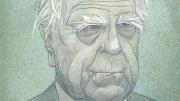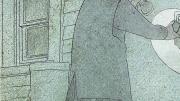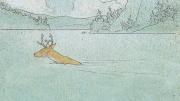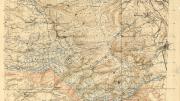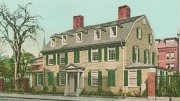It’s not often that a poet is famous enough to become the target of character assassination 50 years after his death. But in November 2013, a half-century after Robert Frost died, Harper’s Magazine published a withering attack on his legend, in the form of a short story by Joyce Carol Oates. The story, “Lovely, Dark, Deep”—its title drawn ironically from one of Frost’s most famous poems, “Stopping By Woods on a Snowy Evening”—describes the attempt of a young woman, Evangeline Fife, to interview the aging Frost in 1951. But the Frost on display here is so odious that the interview soon turns into a confrontation, then an inquisition. After commenting nastily on the poet’s physical appearance—”his torso sagged against his shirt like a great udder”—Oates gives us a Frost who makes lecherous comments, and lies about his past, and trashes other poets, and fails as a father and husband, and displays an overall arrogance and meanness that make him entirely loathsome. The story ends with Frost collapsed on the ground, almost murdered by his interviewer’s contempt.
Oates’s story appears so entirely hostile to Frost that the reader starts to wonder about its real meaning. Does Oates, in fact, want us to share Fife’s anger at the old poet? Are all the accusations she hurls meant to be taken at face value? Or is this episode, perhaps, a dramatization of the cruel and inhumane ways that posterity treats great writers, especially when it comes time to write their biographies? After all, it was none other than Joyce Carol Oates who wrote critically, in 1988, about the rise of “pathography,” a variety of literary biography “whose motifs are dysfunction and disasters, illnesses and pratfalls, failed marriages and failed careers, alcoholism and breakdowns and outrageous conduct.” Such an approach to a writer’s life, Oates observed in The New York Times Book Review, can answer every question except the most important one: “How did so distinguished a body of work emerge from so undistinguished a life?”
And as a leading example of such pathography, Oates cited the three-volume biography of Frost, class of 1901, Litt.D. ’37, by Lawrance Thompson, which she described as a work of “true malevolence.” Indeed, Thompson’s biography of Frost has become notorious as an example of what can happen when a biographer turns completely against his or her subject. Thompson was Frost’s hand-picked, authorized biographer, but as he came to know his subject over the decades he took to write the book, he came to see Frost in much the same way that Evangeline Fife sees him in Oates’s story: as a monster of egotism, who inflicted harm on his friends and family. Jay Parini, whose own biography of the poet, Robert Frost: A Life, was written in part as a corrective to Thompson, described the Frost who emerges in the Thompson biography as “a selfish, egomaniacal, dour, cruel, and angry man.”
Thompson’s portrait of Frost was like a bomb dropped on the poet’s legend. The critic David Bromwich, writing about the last volume of Thompson’s biography in 1977, said that after reading it, “one feels that to stand in the same room with a man about whom one knew a quarter of the things one now knows about Frost would be more than one could bear.” But biography could do so much damage only because that legend was itself so imposing, and so carefully tended. Starting in the 1910s, around the time he turned 40, Robert Frost became the most famous American poet—and not just the most famous, but the best-loved, the one who seemed to embody all that America liked most about itself. At a time when modern poetry was growing increasingly arcane, here was a poet who wrote in straightforward language about ordinary New England farmers and laborers—a democrat in form and substance.
On a thousand podiums, Frost helped to create the image of a homespun American sage, reading his poems and delivering himself of crafty jokes and wise sayings. You can see this performance in action in The Collected Prose of Robert Frost, a volume in the continuing Harvard University Press (HUP) edition of Frost’s complete work. Once he became famous, Frost did not write much prose, and many of the items in the book are lectures or occasional remarks. But one exception is a baseball article published in Sports Illustrated, a description of the All-Star Game that Frost attended in 1956:
Americans would rather watch a game than play a game. Statement true or false? Why, as to these thousands here today to watch the game and not play it, probably not one man-jack but has himself played the game in his athletic years and got himself so full of bodily memories of the experience (what we farmers used to call kinesthetic images) that he can hardly sit still. We didn’t burst into cheers immediately, but an exclamation swept the crowd as if we felt it all over in our muscles when Boyer at third made the two impossible catches, one a stab at a grounder and the other a leap at a line drive that may have saved the day for the National League.
Here is the poet as common man, immersing himself in the crowd—note that inclusive “we”—and reveling in the American pastime. (Just try to imagine T.S. Eliot, A.B. 1910, A.M. ’11, Litt.D. ’47, writing about, or even attending, the All-Star Game.) Yet as always with Frost, this folksy statement contains a little sting in the tail, an escape hatch. When he writes about “what we farmers used to call kinesthetic images,” he means us to register the contrast between the technical word and the presumed simplicity of the countryside. Frost, though he may have run a farm, is clearly more than a farmer; he is, just below the surface, a freethinker, an intellectual. That is why reading him rightly means being alert to Frost’s sly subversions of his own image. He hid himself in his legend in just the same way that the animal hides in his poem “A Drumlin Woodchuck”:
My own strategic retreat
Is where two rocks almost meet,
And still more secure and snug,
A two-door burrow I dug.With those in mind at my back
I can sit forth exposed to attack,
As one who shrewdly pretends
That he and the world are friends.
(Reprinted by arrangement with Henry Holt and Company, LLC. All rights reserved.)
To coax the poet out of his retreat takes tact and caution; it means reading him not as a prosecutor but as an interpreter. That is why HUP’s new edition of Frost’s letters, edited by Donald Sheehy, Mark Richardson, and Robert Faggen, Ph.D. ’88, is so valuable. Collections of Frost’s letters to individual correspondents have been published in the past, but this edition—projected to fill three volumes—is the first to give us the complete letters in chronological order, including hundreds never available before. Like the previous volumes in the press’s pioneering Frost edition—the Collected Prose and the enigmatic but revealing Notebooks—The Letters of Robert Frost helps readers cut through biographical opinion, pro or con, and form their own theories about who Frost was and what drove him. And the first volume, covering the years 1886 to 1920, to be published this February, is likely to be the most revealing of all, because it covers the crucial first half of Frost’s long life—the years in which he transformed himself from an unknown New Hampshire farmer and schoolteacher into America’s leading poet.
Frost is so closely identified with New England that it comes as a surprise to learn that, in fact, he spent the first decade of his life a continent away, in San Francisco. He liked to point out that his father came from an old New England family, while his mother was a first-generation American, an immigrant from Scotland; this gave him access to two kinds of typical American experience. Frost’s father died in 1885, when the boy was just 11 years old, and this crisis led the family to move back east, to be near their Frost relatives. But they did not move to what we typically think of as Frost country, the rural areas “North of Boston”—to use the title of his second book of poems—that he would make famous in his verse. Rather, it was in the industrial town of Lawrence, Massachusetts, that Frost went to high school, graduating at the top of his class.
No one looking at the course of Frost’s life during the next 20 years, however, could have predicted that he would go on to great things. He started at Dartmouth, but dropped out after less than a semester: “I wasn’t suited for that place,” he explained. He proved no more suited to Harvard, where he was given special permission to enroll at the relatively advanced age of 23, in 1897. This time he lasted three semesters before deciding, once again, that college was not for him: “They could not make a student of me here, but they gave it their best,” he recalled later in life. Matters weren’t helped when he showed some of his poems to his English A instructor, only to be told that they were no good.
Thanks to an inheritance from his grandfather, Frost was in no danger of poverty. With family money, he bought a farm in Derry, New Hampshire, where he farmed with indifferent success, and then spent several years as a teacher at the Pinkerton Academy. Few if any of his neighbors had an inkling of his literary ambitions: in worldly terms, he must have looked directionless, even a failure. Yet Frost was a great Emersonian—in a late essay, he writes of having grown up “under the auspices of Emerson”—and all the while he was practicing his own quiet version of self-reliance. “There comes a time in every man’s education when he arrives at the conviction that envy is ignorance; that imitation is suicide; that he must take himself for better, for worse, as his portion,” Emerson wrote in “Self-Reliance.” In that spirit, Frost trusted himself enough to know what experiences and environments would nourish him as an artist, and which would thwart him. Like Bartleby, he had the courage to “prefer not to”—not to go to college, not to make a career—no matter what the world might make of his refusals. “Cut and run away from every care: that is the rule,” he wrote a friend in 1917. “Nothing else will do.”
That Frost thought of himself as an artist from the very beginning, long before the world recognized him as such, is made clear from his early letters. His most important correspondent in the 1890s was Susan Hayes Ward, a New York editor who encouraged Frost by being the first to publish one of his poems—“My Butterfly,” in 1894. On this slender basis, Frost began to treat her as a confidant, and what he had to confide was his “inflexible ambition.” (“It is only a matter of time now when I shall throw off the mask and declare myself for literateur mean it poverty or riches,” he insists at the age of 20.) Nor does Frost try to conceal the magnitude of his self-confidence: “my natural attitude is one of enthusiasm verging on egotism,” he tells Ward, “and thus I always confuse myself trying to be modest.”
Until he reached the age of 37, however, modest is exactly the word to describe Frost’s literary career. New York editors displayed no interest in his work—“my poetry…didn’t seem to make head as fast as I could wish with the public,” he writes in 1912—and there is something almost desperate in the way he clings to Susan Ward as his one acquaintance in the literary world. All of this made it only more impressive when, in August 1912, Frost suddenly decided to move himself and his family—his wife, Elinor, and four children—to England. He knew no one in London, and had no concrete reason to think that he would find any more success there than he had at home. But again, his instinct of self-reliance allowed him to act with a seemingly unjustified confidence: “My soul inclines to go apart by itself again and devise poetry,” he tells Ward.
It was a great gamble, and the letters show how quickly it paid off. Within months, Frost had made the acquaintance of leading English poets, and was validated as a poet himself. “I was only too childishly happy in being allowed to make one for a moment in a company in which I hadn’t to be ashamed of writing verse,” he tells the poet F.S. Flint in January 1913. Before the year was out, his first book, A Boy’s Will, had appeared in England, to be followed in 1914 by North of Boston—a book of New England eclogues written mostly in Old England. The acclaim these books received in London—thanks in part to Ezra Pound, that great scout of poetic talent—echoed back to New York, and Henry Holt took on Frost as an author, starting a relationship that would last the rest of his life. No less important was the beginning of Frost’s deep friendship with the English poet Edward Thomas, whom he would later describe—after Thomas was killed in World War I—as “the only brother I ever had.”
By the time Frost returned to America in February 1915, his life had changed forever. Practically as soon as he was off the boat, the same editors who used to ignore him now clamored to publish him and celebrate him. He became friends with leading literary figures like Amy Lowell, a poet and propagandist for Modernism, and Louis Untermeyer, a prominent editor and anthologist. In 1916, almost 20 years after he had dropped out of Harvard, he was invited to deliver the Phi Beta Kappa poem at Harvard’s Commencement—a perfect emblem of his reversal of fortune, and a justification for his unconventional career. In a letter to Untermeyer in May 1916, Frost described himself jokily but quite accurately: “Chief occupation (according to Who’s Who) pursuit of glory; most noticeable trait, patience in the pursuit of glory.”
When it finally came, however, glory came to Frost in such a rush that it forced the drumlin woodchuck back into its burrow. Only this time, instead of hiding in obscurity, Frost had to find a way to hide his true self in the glare of publicity. You can see this transformation taking place in the Letters. The openness to new friendships and experiences that characterizes his English period gives way, very quickly, to a kind of wary artificiality, as Frost gets used to playing the role of the great writer. Frost’s letters to Edward Thomas are tender and self-revealing; his letters to Louis Untermeyer are antic and impersonal, full of put-on voices and literary gossip.
Notably, the Frost who had previously been indifferent to money now becomes quite sharp in demanding lecture fees and teaching salaries. Bargaining with the president of Amherst College, who had offered him the first of what would become a series of lucrative sinecures at American campuses, Frost writes: “It is the hard fate of the unworldly to have to be more worldly than the worldly sometimes to make up for the other times when they are less worldly.” It is clear that he sees money as an index of esteem, and that his years of obscurity left him with a bottomless thirst for recognition.
In his early forties, then, two paths began to diverge for Robert Frost; but unlike the speaker of his famous poem, he did not choose just one. Instead, he became simultaneously the public man, performing as himself in lectures and readings, and the private artist, committed to the fundamentally antisocial life of poetry. In fact, this kind of doubleness, this suggestion of concealed depths, is key to the power of Frost’s work.
On one level, it is no wonder that his poems—so apparently plainspoken, so easy to read, if not always to fully understand—are staples of the high-school curriculum. Where “The Waste Land” requires pages of footnotes, and even then refuses to come completely into focus, Frost’s “Stopping by Woods on a Snowy Evening”—written in the same year Eliot’s masterpiece was published, 1922—seems as straightforward as a Currier and Ives print. We can see the snowy woods, the farmhouse, the horse who “gives his harness bells a shake.” The poem would be almost banal, were it not for the famous repetition at the end:
The woods are lovely, dark, and deep,
But I have promises to keep,
And miles to go before I sleep,
And miles to go before I sleep.
(Reprinted by arrangement with Henry Holt and Company, LLC. All rights reserved.)
The repeated line changes the poem from a country vignette into something much stranger and richer. It becomes a kind of death-wish, an expression of longing for a sleep that is at the same time oblivion—the oblivion promised by the woods, so dark and deep that a man might enter them and never be found again. This is nowhere explicit, yet the tone of that last line makes it impossible to miss—a perfect demonstration of Frost’s central poetic principle, that the sound of a sentence matters more to its meaning than the individual words.
The idea of disappearing into the woods, the trope of flight and oblivion, marks Frost’s poetry from the very beginning. Just look at the first poem in A Boy’s Will, his debut book. “Into My Own” shows Frost already longing for a flight that is a kind of death:
One of my wishes is that those dark trees,
So old and firm they scarcely show the breeze,
Were not, as ’twere, the merest mask of gloom,
But stretched away unto the edge of doom.I should not be withheld but that some day
Into their vastness I should steal away,
Fearless of ever finding open land,
Or highway where the slow wheel pours the sand.
(Reprinted by arrangement with Henry Holt and Company, LLC. All rights reserved.)
For this poet, disappearance is self-discovery: at the conclusion of the poem, he writes that running away into the woods would leave him “Only more sure of all I thought was true.” Frost becomes himself fully only by acknowledging the deep pull toward “doom” that is part of his poetic inspiration. And in fact, the more closely one reads Frost’s poetry, the more incredible it becomes that he was ever taken as an anodyne Yankee poet, or that his profound bleakness should be considered suitable reading for children. Many of his best poems abound with images of death, disappearance, suicide, loneliness, and futility.
The critic Lionel Trilling put his finger on the essence of Frost’s art when, at a dinner celebrating the poet’s eighty-fifth birthday in 1959, he made a famous speech describing Frost as “a terrifying poet.” Americans, Trilling said, tended to regard Frost as “virtually a symbol of America…not unlike an articulate…Bald Eagle,” when in fact his genius lay in “the representation of the terrible actualities of life.” When these remarks were reported in the press, they caused an extraordinary controversy, as readers wrote in to defend the Frost they loved against the seeming perversity of a meddling highbrow critic.
Yet Trilling turned out to be a truer friend of Frost’s poetry than such readers knew. After all, once the legend of the benevolent Frost melted away under the harsh light of biography, or “pathography,” all that remained to keep the interest of posterity was Frost the artist. And the artist had already confessed, in surprisingly direct terms, to all the turmoil and grief that became a scandal to the public. Indeed, in almost every case, surprise at an artist’s personal flaws is a sign that he or she has been misread. Could it have been a guiltless person who wrote “Acquainted with the Night”?
I have been one acquainted with the night.
I have walked out in rain—and back in rain.
I have outwalked the furthest city light.I have looked down the saddest city lane.
I have passed by the watchman on his beat
And dropped my eyes, unwilling to explain.
(Reprinted by arrangement with Henry Holt and Company, LLC. All rights reserved.)
But the darkness of Frost’s poetry is not merely personal, and certainly not confessional, in the way that later poets like Robert Lowell ’39 and John Berryman would be. Those poets believed in putting down the facts of their lives on the page—each published a poem which included his home address—and they found their motto in Lowell’s famous line from his poem “Epilogue”: “Yet why not say what happened?”
Frost, on the other hand, believed that experience had to be transformed into metaphor in order to make poetry. “People say, ‘Why don’t you say what you mean?’” he writes in “Education by Poetry,” a 1931 essay, anticipating Lowell’s question by decades. But in Frost’s view, speaking in metaphor—saying one thing in terms of another thing—was not just the principle of poetry; it was at the heart of all speech. “We like to talk in parables and in hints and in indirections—whether from diffidence or some other instinct.” And he goes even further, suggesting that “metaphor [is] the whole of thinking.” What philosophy and poetry have in common, Frost writes, is “the attempt to say matter in terms of spirit, or spirit in terms of matter, to make the final unity.”
The belief that matter is but a metaphor for spirit was the essence of American transcendentalism, and Frost often feels like the last of the Transcendentalists, a late descendant of Ralph Waldo Emerson. Indeed, in his Emerson essay, he makes the connection explicit: “I owe more to Emerson than anyone else for troubled thoughts about freedom.” The key word here, however, is “troubled.” For the union of spirit and matter that Emerson believed in was for Frost rather a source of doubts and questions: the attempt to “make the final unity,” he wrote, was “the greatest attempt that ever failed.”
Some of Frost’s most famous poems deal with that failure—moments when the universe, rather than reflecting us back to ourselves, seems to confront us with its absolute otherness, its refusal to serve as metaphor. That is what happens in “The Most of It,” where the poet, longing to hear some “counter-love, original response” from the natural world, is given only an uninterpretable sign:
And nothing ever came of what he cried
Unless it was the embodiment that crashed
In the cliff’s talus on the other side,
And then in the far-distant water splashed,
But after a time allowed for it to swim,
Instead of proving human when it neared
And someone else additional to him,
As a great buck it powerfully appeared,
Pushing the crumpled water up ahead,
And landed pouring like a waterfall,
And stumbled through the rocks with horny tread,
And forced the underbrush—and that was all.
(Reprinted by arrangement with Henry Holt and Company, LLC. All rights reserved.)
What is it that appears as a great buck? Certainly not the “counter-love” the poet hoped for, since this is a show of brute strength, without speech or meaning. And yet Frost speaks of it as an “embodiment,” that is, as a metaphor—of something, though we can’t say exactly what. This sense of baffled understanding, of nearly but not quite grasping the world’s meaning, is one of the constant themes of Frost’s verse. It can be found even in so seemingly pastoral and innocent a poem as “Birches,” where the image of a boy rising to the top of a tree and then bending back down to earth becomes a metaphor for almost reaching the Godhead that human beings can never quite experience.
There is only one sphere in which metaphor is able to function, where spirit can be said in terms of matter, and that is poetry itself. That is why poetry, for Frost as for Emerson, is the essence of language, without which it is impossible to think at all. “The metaphor whose manage we are best taught in poetry—that is all there is of thinking. It may not seem far for the mind to go but it is the mind’s furthest,” Frost writes. Poetry, speech, metaphor, are the ways human beings transform the brute materiality of the world into meaning. The reason we still love Robert Frost, and owe him gratitude, is not that he was a good father or husband or an admirable man. After all, most of us are not admirable, and almost no one goes through life without inflicting some harm. It is, rather, because he was able, like only a handful of American writers before or after him, to work the transformation he describes in his poem “The Aim Was Song”:
Before man came to blow it right
The wind once blew itself untaught,
And did its loudest day and night
In any rough place where it caught.Man came to tell it what was wrong:
It hadn’t found the place to blow;
It blew too hard—the aim was song.
And listen—how it ought to go!He took a little in his mouth,
And held it long enough for north
To be converted into south,
And then by measure blew it forth.By measure. It was word and note,
The wind the wind had meant to be—
A little through the lips and throat.
The aim was song—the wind could see.
(Reprinted by arrangement with Henry Holt and Company, LLC. All rights reserved.)
